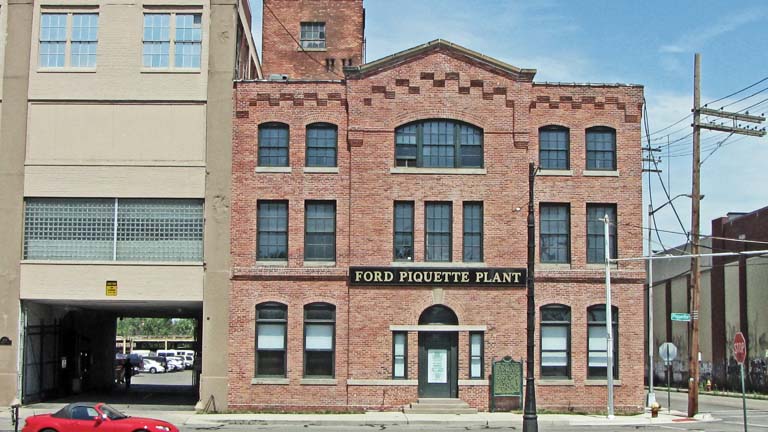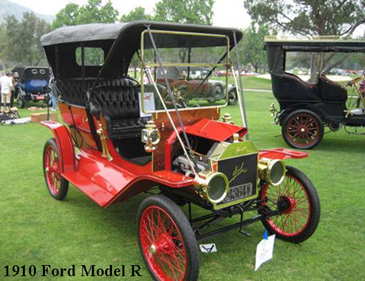

Henry Ford built his first motorized vehicle
in a one-story brick workshop at 220 Bagley in the late 1890s. By 1899,
he attempted to produce automobiles
in larger numbers. For a time, Ford rented a small building on Mack to manufacture his
cars but his firm was not successful and he lost control of it to bankers and to Henry Leland. On June 16, 1903 Henry Ford and 12 other Detroit men met in the offices
of architect Alexander Malcomson, located at the intersection of Griswold and
Jefferson, to organize the Ford Motor Company. They provided the financial
resources to build this factory at the corner of Piquette and Beaubien. Horace
Rackham was one of the founders, a man who contributed substantial funds
to the
University of Michigan, attaching his name to one impressive building in Ann
Arbor and another at the c orner of Warren and Woodward in Detroit.
orner of Warren and Woodward in Detroit.
The Detroit architects Henry Field, Theodore Hinchman and Fred Smith designed this Piquette Street plant for the production of Ford cars. It is a three-story, mill-style building that predated the use of reinforced concrete. The floors were oak planks that got soaked with grease and oil. It resembles a 19th century New England textile mill. Fire was a major concern, so each floor was divided into four separate sections using firewalls. Presumably, if a fire broke out, it could be contained to one section of one building. There is a decorative battlemented cornice on the Piquette street front of this building. The location was selected, in large part, because of its location at the railroad crossing known as Milwaukee Junction; that is, the intersection of the Michigan Central belt line that connected with their main line to Chicago and the Grand Trunk line that extended from Detroit to Grand Haven where freight cars were put on ferries for Milwaukee and points West.
Henry Ford designed the Model T in this building, presumably in secret since his financial backers presumed he was building more expensive and thus more profitable cars. The first Model T's was built in this structure and got to the streets of Detroit on October 1, 1908. By 1909, Ford was assembling many of them in this building. He attempted to increase production but the size of this plant, about 400 by 56 feet, was too small, so as early as 1911, Ford started shifting production to the large new plant he was constructing in Highland Park. However, this Piquette Avenue plant was where Ford began to experiment with assembly line production. He set a record with the production of 110 cars in the ten hour shift.
In 2002, an historical organization—the Model T Automotive Heritage Complex—secured ownership of this building and began the process of turning it into a museum. In 2002, they were successful in having it declared a National Historic Landmark. This is an exceptionally significant designation. Other National Historic Landmarks in the Detroit area include Cranbrook; Ford's Highland Park Assembly Plant; Ford's River Rouge plant; Ford's Fairlane Home in Dearborn; the Henry Ford Museum and Greenfield Village; the Fisher Building;the Fox Theater Building; the Guardian Building; the General Motors Building in the New Center area; the Parke-Davis Historic District on the Detroit River and the Pewabic Pottery Building on East Jefferson.
Architects: Henry Field, Theodore Hinchman and Fred Smith
Date of Completion: 1904
Use in 2010: This building is maintained by an historical society that to commemorate
the development of Ford cars,
especially the Model T
Website: http://www.tplex.com
City of Detroit Designated Historic District: Not listed
State of Michigan Registry of Historic Sites: Not listed
National Register of Historic Places. This building was designated a National Historic Landmark on February 22, 2002, #02000041
Photo: Ren Farley; July, 2002
Description updated: May, 2010
Return to Michigan Historic Landmarks